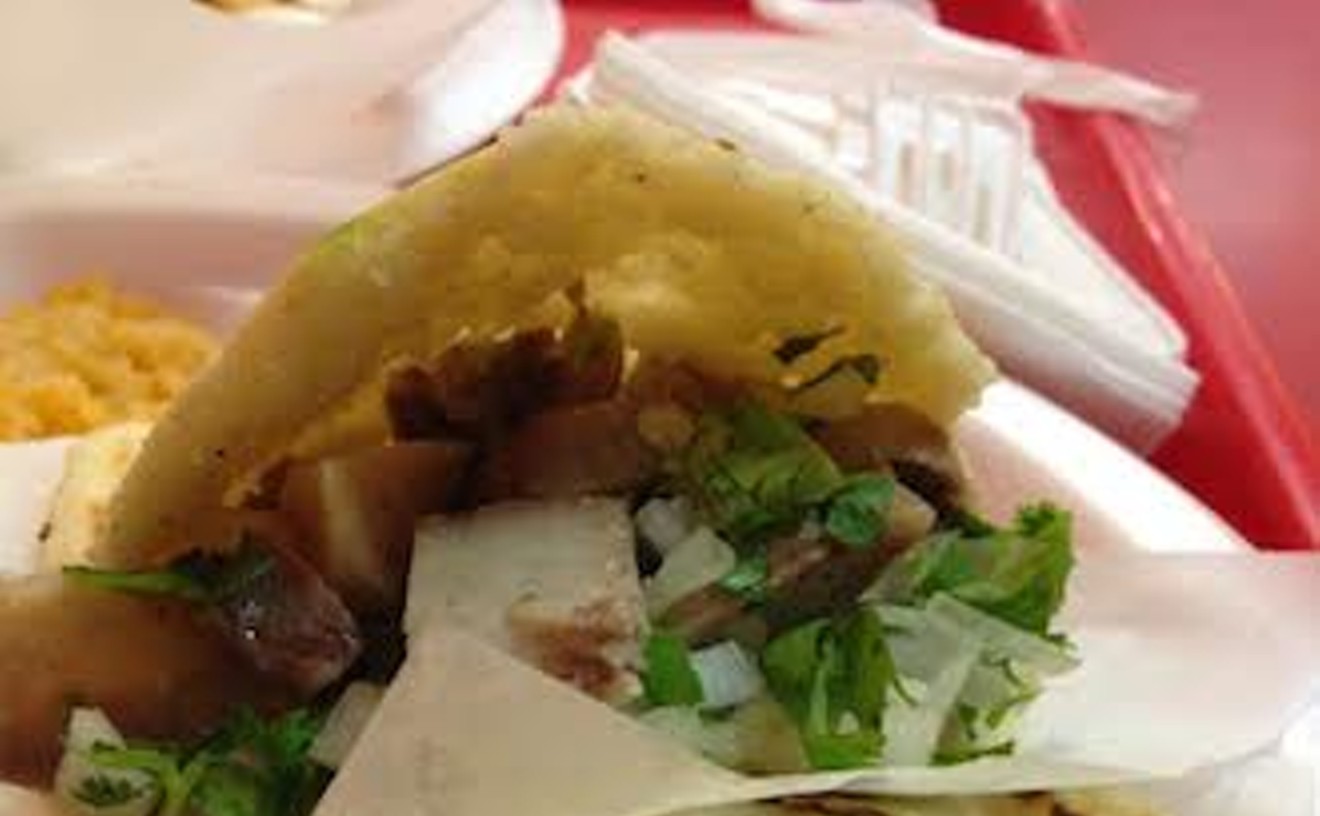We've said it once and we'll say it again: Chef Silvana Salcido Esparza's guacamole is the best in town. True, there's something to be said about a simple, well-executed bowl of creamy guacamole, but we can't help dreaming about the heartier, fancier version found at the chef's famous Barrio Cafe. Her guacamole features fresh avocados, tomato, red onion, cilantro, jalapeño, lime juice, and pomegranate seeds to make for a dip that's anything but boring. The balance between tart and sweet makes it addicting. Yes, the fanfare of the tableside show comes with a larger-than-average price, but we promise you won't regret the extra dollars once you try it.
Best Guacamole
Barrio Cafe
In Spanish, its name means "goat sucker," which is meant not as a pejorative but rather a description of the dietary habits of the chupacabra, a mythical creature who's occasionally seen stalking the desert. The name comes from the animal's penchant for killing and drinking the blood of small animals, especially goats.
In terms of legendary creatures, the chupacabra is relatively young. Early sightings occurred in Puerto Rico in 1995, and domestic visits from the little monster also have been reported. The goat-sucker also must be a shape-shifter, because descriptions of it vary. In Russia, it's the size of a bear, with spines from its head to its tail; in Maine, it's more dog-like, with long, sharp teeth and bald, pink skin. And there have been plenty of sightings near metro Phoenix. Always, the chupacabra has a sour disposition and a thing for eating other animals.
Biologists and wildlife management officials consider the chupacabra a contemporary legend and usually explain it away as a rabid dog. A five-year study by scientist Benjamin Radford failed to prove either the animal's existence or the reports that it drains its victims of their blood. Radford concluded that reports of chupacabra — at least in the United States — are in fact dogs and coyotes with mange, which causes their fur to fall out and their skin to bunch up and thicken.
Otherworldly creatures? Mangy dogs? No matter — the chupacabra has gone small-screen, and that makes it real. CNN's Ed Lavandera has discussed the chupacabra on air, describing it as the "Bigfoot of Latino culture." Better yet: The goat-sucker has had a featured role in something called Scooby-Doo! and the Monster of Mexico.
Best Salsa
Carniceria Los Pinos
Making good salsa is not easy. Finding the balance of chiles, garlic, and salt while still imparting a memorable flavor is sometimes best left to those who have been doing it for years. The folks at Carniceria Los Piños put out a refrigerator full of three different kinds of salsas and a spicy guacamole every day. Choose from two red salsas — the classic, which leaves a welcomed burning sensation causing you to reach for more, and the totalmente salsa, with its roasted pepper taste. The salsa verde is an all-time favorite, made with fresh tomatillos and excellent on just about anything it touches.
- 4832 N. 27th Ave., Phoenix, 85017 Map
- 602-336-0234
Best Elote
Fruitlicious
Elote (simply put, corn) has gained favor in respected restaurants, making its way onto menus for about $5. So, sure, you could say it's trendy. But head down to South Phoenix and there lies the mecca of Mexican street foods, with prices equivalent to the streets. Instead of serving corn on the cob, Fruitlicious slices off the corn from the cob and puts it in a cup with a dollop of mayo, lime juice, cotija, and chili powder. It's a mess-free way to indulge in the hot and creamy goodness of an all-time favorite without having to fork out unnecessary money that very well could be spent on the other enticing snacks Fruitlicious creates.
- 3424 W. Southern Ave., Phoenix, 85041 Map
- 602-442-5584
- www.facebook.com/fruitlicious1
There are people who believe that Ernesto Arturo Miranda was murdered in a setup by angry cops out for retribution, because he's the reason they have to read you your Miranda rights every time they bust you. Still others think Miranda's death in a knife fight in a seedy Phoenix bar was a grisly fait accompli.
Born in Mesa in 1941, Miranda was trouble from the word "go." His first criminal conviction came in the eighth grade. By the following year, he'd been booked on burglary charges and sent to reform school. Later, after his release, Miranda served time in Los Angeles for various petty crimes and was extradited to Arizona once he was free.
On March 13, 1963, Miranda was hauled into a Phoenix station house on rape and kidnapping charges, having been positively identified by victim Lois Ann Jameson. After two hours of investigation, during which time he was never informed of his rights, Miranda confessed to the crimes.
Sentenced to 20 to 30 years on both charges, Miranda appealed to the Arizona Supreme Court in June 1965. The American Civil Liberties Union and attorneys from the law firm Lewis and Roca represented Miranda, arguing that his Fifth Amendment rights — to remain silent and not to incriminate himself — had been violated.
He won the appeal but lost a retrial and, based on evidence against him, went to prison anyway. Still, his victory was the mandatory reading of rights ("You have the right to remain silent. If you give up the right to remain silent, anything you say can and will be used against you in a court of law . . .") by every arresting police officer in the country.
Paroled in 1972, the ex-con made his living selling autographed Miranda warning cards for $1.50 and got busted a bunch more times. After being released from what would be his last prison sentence, Miranda was killed in that knife fight. His murderer has never been positively identified. The lead suspect, a Mexican national named Eseziquiel Moreno, supposedly headed back to Tijuana and escaped prosecution.
According to legend, Miranda's pockets were stuffed with autographed Miranda Rights cards on the night he died.
Best Nopales Dish
Comedor Guadalajara

Most are not comforted when spotting cactus (nopales) on a menu, but Comedor Guadalajara got smart and put it into a classic: the quesadilla. Packed with cheddar cheese, chunks of grilled chicken, red and green bell peppers, and cactus, the dish is an easy way for cactus newbies and experts alike to enjoy the desert plant. The semi-acidic taste of the cactus complements the bitter taste of the green bell pepper. After indulging in cactus for the first time, you'll quickly realize that eating native Arizona vegetation never tasted so good.
- 1830 S. Central Ave., Phoenix, 85004 Map
- 602-253-8299
- www.comedorguadalajara.com
Your taste buds don't care who invented the chimichanga, but how true is the story about it being accidentally created right here in Arizona?
One story goes that the famous Mexican entrée was invented by Woody Johnson, founder of Macayo's Mexican Kitchen. Woody always swore that the chimi belonged to him, that he crafted the very first one known to man in 1946, when he put a burrito into a deep-fat fryer at Woody's El Nido, the diner that later became Macayo's in 1952. His fried burritos became so popular, Woody claimed, that people lined up outside his new restaurant for what he called chimichangas.
But Monica Flin, owner of Tucson's El Charro restaurant, always claimed that it was she who named and invented the chimichanga, after accidently dropping a burro into a fryer in the early 1920s. She reportedly yelled the nonsense word "chimichanga!" following her mistake and, if you believe this tale, a Mexican-American menu item was born.
Then there's the version of the story that gives the dish back to its people: Chivichangas, small, deep-fried burritos, have long been a staple of Sinaloan cuisine. It's thought that the Sinaloans brought chimis with them through Nogales into Arizona in the late 19th century.
Quite honestly, we don't care who invented it. As long as it's deep-fried, filled with chili con carne, and covered in sour cream and guacamole, we'll believe whatever you tell us about the chimichanga.
Best Nopales Drink
Courtyard Café, the Heard Museum

Don't be deceived: That glass filled with what looks like pink lemonade is not pink lemonade. It's prickly pear lemonade, made with the beautifully bright purple fruit that grows every summer on prickly pear cactus (a.k.a. nopales). The flavor is a cross between watermelon and bubblegum, but without the tart aftertaste. We can't quite put our finger on it, but one thing that is certain is the prickly pear lemonade is the grown-up sister to your average glass of lemonade. What could be more relaxing than sipping on the fresh concoction under the shade of trees with wind blowing through the cafe?
- 2301 N. Central Ave., Phoenix, 85004 Map
- 602-251-0204
- www.heard.org/visit/dining.html
Best Aguas Frescas
Gorditas El Tio

The only thing worse than stale pan dulce is filtered aguas frescas that have been sitting all day. So how come huge vats with various flavors of aguas frescas don't fill the counter space of Gorditas El Tio accompanied by dried-out fruit art in front indicating the flavor? Because all aguas frescas are made to order without the unnecessary frill. You can even look in the kitchen and watch the cooks toss all the fresh fruit into the blender and whip it up. Down a fresh glass of horchata or a creamy, fruity mix of mango to satisfy your sweet tooth.
- 3202 E. Greenway Rd., Phoenix, 85032 Map
- 602-867-9032
- www.facebook.com/GorditasElTio/
Best Raspados
Raspados Neza
Raspados used to be known as street food, sold on carts in Phoenix neighborhoods. The jingle of a bell or the honk of a horn used to be the indication that refreshment was on its way. Now shops are popping up all through the Valley, filling our cups and stomachs with shaved ice and fresh fruit topped with sweet cream. This modest West Valley raspado shop the turns out Mexican snow cones with flavors like eggnog, tamarind, strawberry, and mango, all piled high atop the rim of the cups to resemble a mountain swirled with fresh fruit.
- 10575 W. Indian School Rd. #106, Avondale, 85392 Map
- 602-539-0373
- www.facebook.com/RaspadosNezaArizona/






